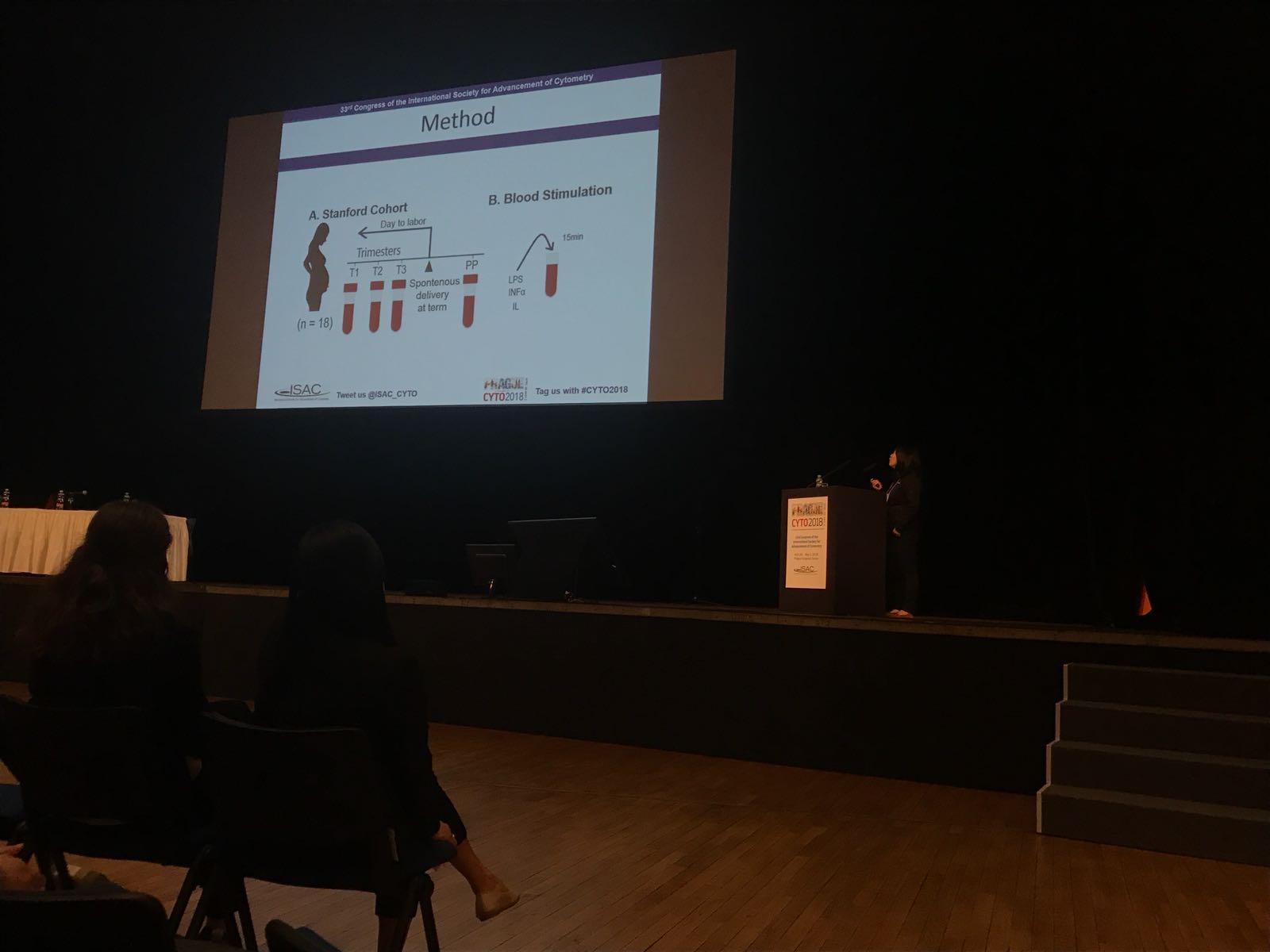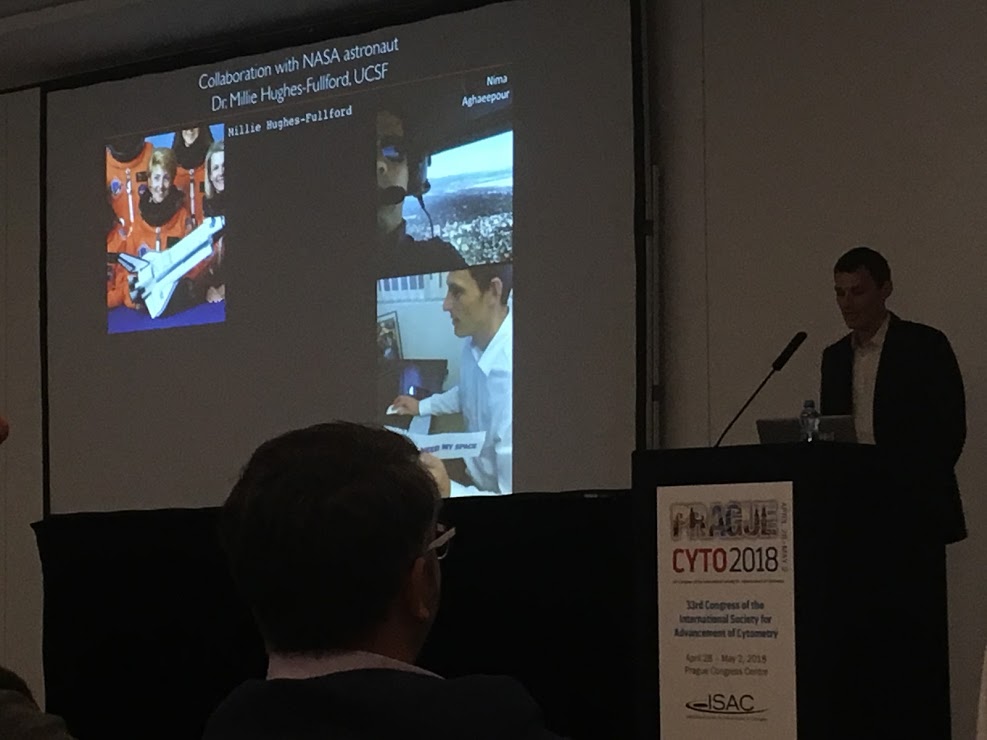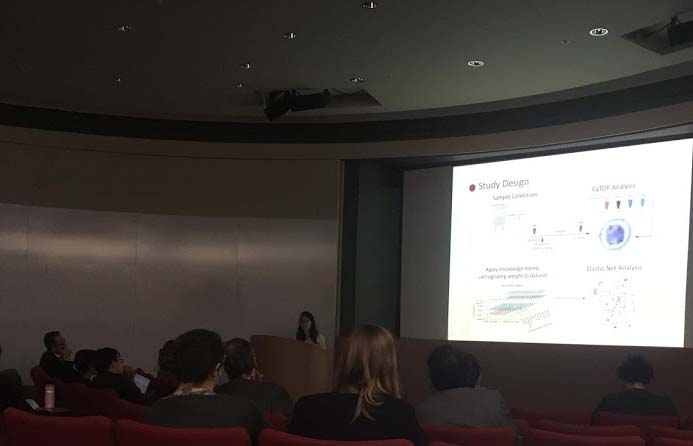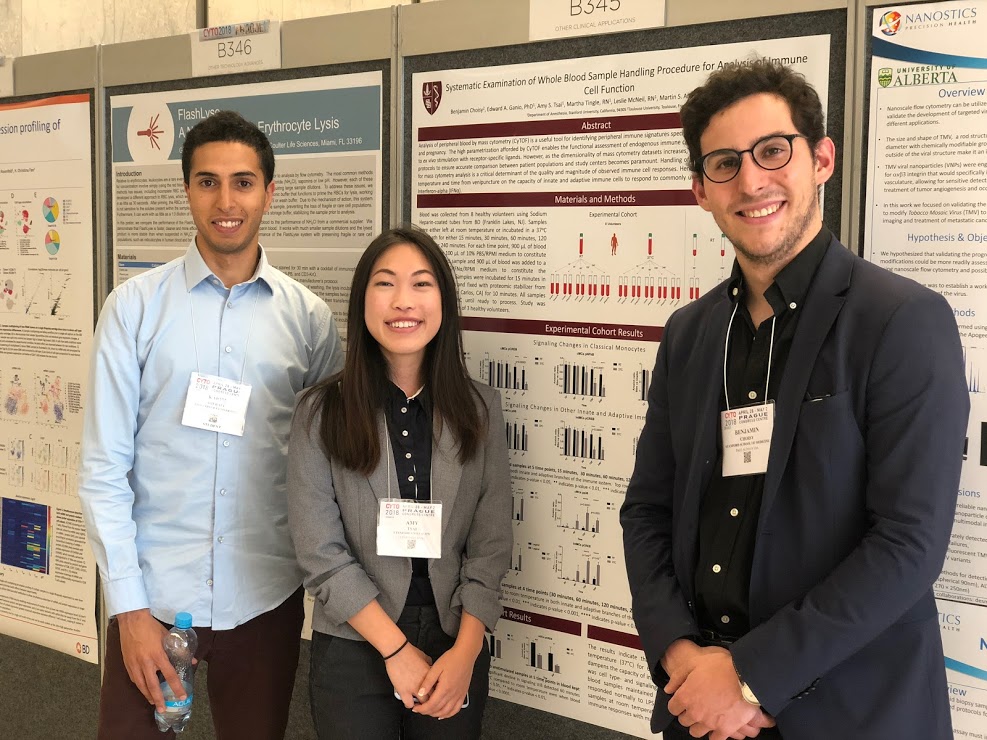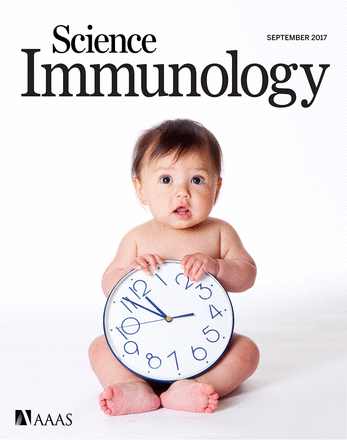Lab News
General Lab News
APRIL
[8 Apr 2022] Congratulations to Amy Tsai for her first-place presentation on “Integrating Single-cell and Plasma Proteomic Modeling to Predict Surgical Site Complications” at the California Society of Anesthesiology’s Annual Meeting!
MARCH
[18 Mar 2022] Congratulations to Amy Tsai, MS4 for winning the Kosaka Top Scholars Award at IARS for her presentation on “Integrated Single-cell and Plasma Proteomic Modeling to Predict Surgical Site Complications, A Prospective Cohort Study”! Read more here.
FEBRUARY
JANUARY
[1 Jan 2022] We welcome back Dr. Jakob Einhaus, MD as a postdoctoral fellow!
DECEMBER
[23 Dec 2021] Congratulations to Dr. Kristen Rumer, Julien Hedou and Amy Tsai on their work on Integrated Single-Cell and Plasma Proteomic Modeling to Predict Surgical Site Complications. In a collaborative effort between the Departments of Surgery and Anesthesiology, the study identifies early immune dysregulation that can predict surgical site complications later on.
Objective: The aim of this study was to determine whether single-cell and plasma proteomic elements of the host’s immune response to surgery accurately identify patients who develop a surgical site complication (SSC) after major abdominal surgery.
Summary Background Data: SSCs may occur in up to 25% of patients undergoing bowel resection, resulting in significant morbidity and economic burden. However, the accurate prediction of SSCs remains clinically challenging. Leveraging high-content proteomic technologies to comprehensively profile patients’ immune response to surgery is a promising approach to identify predictive biological factors of SSCs.
Methods: Forty-one patients undergoing non-cancer bowel resection were prospectively enrolled. Blood samples collected before surgery and on postoperative day one (POD1) were analyzed using a combination of single-cell mass cytometry and plasma proteomics. The primary outcome was the occurrence of an SSC, including surgical site infection, anastomotic leak, or wound dehiscence within 30 days of surgery.
Results: A multiomic model integrating the single-cell and plasma proteomic data collected on POD1 accurately differentiated patients with (n = 11) and without (n = 30) an SSC [area under the curve (AUC) = 0.86]. Model features included coregulated proinflammatory (eg, IL-6- and MyD88- signaling responses in myeloid cells) and immunosuppressive (eg, JAK/STAT signaling responses in M-MDSCs and Tregs) events preceding an SSC. Importantly, analysis of the immunological data obtained before surgery also yielded a model accurately predicting SSCs (AUC = 0.82).
Conclusions: The multiomic analysis of patients’ immune response after surgery and immune state before surgery revealed systemic immune signatures preceding the development of SSCs. Our results suggest that integrating immunological data in perioperative risk assessment paradigms is a plausible strategy to guide individualized clinical care.
SEPTEMBER
[9 Sept 2021] Congratulations to Dr. Kaz Ando and Julien Hedou for their work A peripheral immune signature of labor induction, now published in Frontiers of Immunology!
Approximately 1 in 4 pregnant women in the United States undergo labor induction. The onset and establishment of labor, particularly induced labor, is a complex and dynamic process influenced by multiple endocrine, inflammatory, and mechanical factors as well as obstetric and pharmacological interventions. The duration from labor induction to the onset of active labor remains unpredictable. Moreover, prolonged labor is associated with severe complications for the mother and her offspring, most importantly chorioamnionitis, uterine atony, and postpartum hemorrhage. While maternal immune system adaptations that are critical for the maintenance of a healthy pregnancy have been previously characterized, the role of the immune system during the establishment of labor is poorly understood. Understanding maternal immune adaptations during labor initiation can have important ramifications for predicting successful labor induction and labor complications in both induced and spontaneous types of labor. The aim of this study was to characterize labor-associated maternal immune system dynamics from labor induction to the start of active labor. Serial blood samples from fifteen participants were collected immediately prior to labor induction (baseline) and during the latent phase until the start of active labor. Using high-dimensional mass cytometry, a total of 1,059 single-cell immune features were extracted from each sample. A multivariate machine-learning method was employed to characterize the dynamic changes of the maternal immune system after labor induction until the establishment of active labor. A cross-validated linear sparse regression model (least absolute shrinkage and selection operator, LASSO) predicted the minutes since induction of labor with high accuracy (R = 0.86, p = 6.7e-15, RMSE = 277 min). Immune features most informative for the model included STAT5 signaling in central memory CD8+ T cells and pro-inflammatory STAT3 signaling responses across multiple adaptive and innate immune cell subsets. Our study reports a peripheral immune signature of labor induction, and provides important insights into biological mechanisms that may ultimately predict labor induction success as well as complications, thereby facilitating clinical decision-making to improve maternal and fetal well-being.
[1 Sept 2021] Dr. Dorien Feyaerts presented during the single-cell workshop at the 2021 International Federation of Placenta Associations (IFPA) meeting.
AUGUST
[23 Aug 2021] Congratulations to Dr. Laura Peterson and Julien Hedou for their work Single-Cell Analysis of the Neonatal Immune System Across the Gestational Age Continuum now published in Frontiers of Immunology.
Although most causes of death and morbidity in premature infants are related to immune maladaptation, the premature immune system remains poorly understood. We provide a comprehensive single-cell depiction of the neonatal immune system at birth across the spectrum of viable gestational age (GA), ranging from 25 weeks to term. A mass cytometry immunoassay interrogated all major immune cell subsets, including signaling activity and responsiveness to stimulation. An elastic net model described the relationship between GA and immunome (R=0.85, p=8.75e-14), and unsupervised clustering highlighted previously unrecognized GA-dependent immune dynamics, including decreasing basal MAP-kinase/NFκB signaling in antigen presenting cells; increasing responsiveness of cytotoxic lymphocytes to interferon-α; and decreasing frequency of regulatory and invariant T cells, including NKT-like cells and CD8+CD161+ T cells. Knowledge gained from the analysis of the neonatal immune landscape across GA provides a mechanistic framework to understand the unique susceptibility of preterm infants to both hyper-inflammatory diseases and infections.
JULY
[20 July 2021] NICHD P01 funded! We’re very excited to start working with Dr. Linda Giudice and Dr. Marina Sirota (UCSF) on the new UCSF Stanford Endometriosis Center for Discovery, Innovation, Training and Community Engagement. We will be applying Single-Cell Technologies (CyTOF, IMC, and Transcriptomics) to elucidate niche environments and immune mechanisms involved in endometriosis pathogenesis, pathophysiology, and disease stratification.
[1 July 2021] Congratulations to Dr. Dorien Feyaerts, who was awarded a postdoctoral support grant from Stanford’s Maternal and Child Health Research Institute for the study titled “Cross-tissue assessment of local and peripheral immune determinants of preeclampsia”. This study is a joint collaboration with Dr. Nardhy Gomez-Lopez from Wayne State University.
JUNE
[7 June 2021] In collaboration with Dr. Jordan Spatz and the late Dr. Millie Hughes Fulford, our efforts to characterize the effects of microgravity on the immune system has been published in Nature Scientific Reports. Read Human immune system adaptations to simulated microgravity revealed by single-cell mass cytometry here!
- [7 June 2021, UCSF]: Space Travel Weakens Our Immune Systems – Now Scientists May Know Why
Exposure to microgravity (µG) during space flights produces a state of immunosuppression, leading to increased viral shedding, which could interfere with long term missions. However, the cellular mechanisms that underlie the immunosuppressive effects of µG are ill-defined. A deep understanding of human immune adaptations to µG is a necessary first step to design data-driven interventions aimed at preserving astronauts’ immune defense during short- and long-term spaceflights. We employed a high-dimensional mass cytometry approach to characterize over 250 cell-specific functional responses in 18 innate and adaptive immune cell subsets exposed to 1G or simulated (s)µG using the Rotating Wall Vessel. A statistically stringent elastic net method produced a multivariate model that accurately stratified immune responses observed in 1G and sµG (p value 2E−4, cross-validation). Aspects of our analysis resonated with prior knowledge of human immune adaptations to µG, including the dampening of Natural Killer, CD4+ and CD8+ T cell responses. Remarkably, we found that sµG enhanced STAT5 signaling responses of immunosuppressive Tregs. Our results suggest µG exerts a dual effect on the human immune system, simultaneously dampening cytotoxic responses while enhancing Treg function. Our study provides a single-cell readout of sµG-induced immune dysfunctions and an analytical framework for future studies of human immune adaptations to human long-term spaceflights.
MAY
[8 May 2021] Congratulations to Dr. Dyani Gaudilliere, Amy Tsai, Jakob Einhaus, Julien Hédou and Eileen Tsai on their book chapter, “The Role of Mass Cytometry in Early Detection, Diagnosis, and Treatment of Head and Neck Cancer,” published in Early Detection and Treatment of Head & Neck Cancers, co-edited by Dr. Dyani Gaudilliere.
[5 May 2021] Congratulations to Dr. Ina Stelzer, Julien Hédou, Prof. Xiaoyuan Han, and Dr. Kazuo Ando et. al for their paper’s acceptance to Science Translational! Using whole blood to predict the onset of spontaneous labor. Read it here: Integrated trajectories of the maternal metabolome, proteome, and immunome predict labor onset
- [6 May 2021] The American Association for the Advancement of Science (AAAS): Pregnancy Study Points to New Ways to Accurately Predict Births
- [6 May 2021] The Scientist talks about our new study: Blood Biomarkers Predict the Onset of Labor: Study
- [5 May 2021] French newspaper writes about our latest study: Ce test sanguin permet de prédire la date exacte d’un accouchement
- [5 May 2021] The Telegraph: New blood test can detect when women will go into labour
- [9 May 2021] Our study has been reported by German news! Der Tagesspiegel: Mutter in 3, 2, 1… :So lässt sich der Geburtstermin eines Babys genauer vorhersagen
Estimating the time of delivery is of high clinical importance because pre- and postterm deviations are associated with complications for the mother and her offspring. However, current estimations are inaccurate. As pregnancy progresses toward labor, major transitions occur in fetomaternal immune, metabolic, and endocrine systems that culminate in birth. The comprehensive characterization of maternal biology that precedes labor is key to understanding these physiological transitions and identifying predictive biomarkers of delivery. Here, a longitudinal study was conducted in 63 women who went into labor spontaneously. More than 7000 plasma analytes and peripheral immune cell responses were analyzed using untargeted mass spectrometry, aptamer-based proteomic technology, and single-cell mass cytometry in serial blood samples collected during the last 100 days of pregnancy. The high-dimensional dataset was integrated into a multiomic model that predicted the time to spontaneous labor [R = 0.85, 95% confidence interval (CI) [0.79 to 0.89], P = 1.2 × 10−40, N = 53, training set; R = 0.81, 95% CI [0.61 to 0.91], P = 3.9 × 10−7, N = 10, independent test set]. Coordinated alterations in maternal metabolome, proteome, and immunome marked a molecular shift from pregnancy maintenance to prelabor biology 2 to 4 weeks before delivery. A surge in steroid hormone metabolites and interleukin-1 receptor type 4 that preceded labor coincided with a switch from immune activation to regulation of inflammatory responses. Our study lays the groundwork for developing blood-based methods for predicting the day of labor, anchored in mechanisms shared in preterm and term pregnancies.
MARCH
[01 Mar 2021]: Dr. Ina Stelzer receives a K99/R00 Pathway to Independence Award (NICHD) for her project entitled “Neuromodulation of maternal immune adaptations in pregnancy“
FEBRUARY
[12 Feb 2021] : Congratulations to Dr. Dorien Feyaerts and Julien Hédou for submitting their paper on Integrated plasma proteomic and single-cell immune signaling network signatures demarcate mild, moderate, and severe COVID-19 This is an amazing effort in light of the pandemic in these troubling times.
December
[18 Dec 2020] Our collaborative efforts on studying predictors of preterm birth in developing nations can be found here in JAMA Network Open: Multiomics Characterization of Preterm Birth in Low- and Middle-Income Countries. Congratulations to all who worked on this!
November
[6 Nov 2020] Dr. Ina Stelzer presents Integrated trajectories of maternal metabolome, proteome, and immunome predict the onset of labor at the MCHRI Symposium at Stanford University. | Watch Here.
October
[29 Oct 2020] We received a $50,000 grant from the Doris Duke Charitable Foundation for immunological processes involved in COVID.
[12 Oct 2020] Our work on integrating prior knowledge into mass cytometry analysis is available. Congratulations to Tony Culos and Amy Tsai. Integration of mechanistic immunological knowledge into a machine learning pipeline improves predictions. | Nature Machine Intelligence
The dense network of interconnected cellular signalling responses that are quantifiable in peripheral immune cells provides a wealth of actionable immunological insights. Although high-throughput single-cell profiling techniques, including polychromatic flow and mass cytometry, have matured to a point that enables detailed immune profiling of patients in numerous clinical settings, the limited cohort size and high dimensionality of data increase the possibility of false-positive discoveries and model overfitting. We introduce a generalizable machine learning platform, the immunological Elastic-Net (iEN), which incorporates immunological knowledge directly into the predictive models. Importantly, the algorithm maintains the exploratory nature of the high-dimensional dataset, allowing for the inclusion of immune features with strong predictive capabilities even if not consistent with prior knowledge. In three independent studies our method demonstrates improved predictions for clinically relevant outcomes from mass cytometry data generated from whole blood, as well as a large simulated dataset. The iEN is available under an open-source licence.
September
[1 Sept 2020] Congratulations to Dr. Brice Gaudilliere MD, PhD for his promotion to Associate Professor in the Department of Anesthesiology, Perioperative and Pain Medicine!
August
[4-5 Aug 2020] Dr. Xiaoyuan Han presents “Integrated trajectories of the maternal metabolome, proteome, and immunome predict labor onset” at Cyto2020.
[1 Aug 2020] We received an R35 grant for “Harnessing the human monocyte system to improve surgical recovery”: Identifying immunological mechanisms that predict a patient’s recovery after surgery and point at modifiable targets for the development of immune-modulating interventions that will safely accelerate surgical recovery.
[1 Aug 2020] We say goodbye to two of our lab members: Dr. Kristen Rumer MD,PhD will begin her Colorectal Surgery Clinical Fellowship at Cleveland Clinic Florida and Eileen Tsai, BS will attend The Ohio State University College of Medicine as an MS1.
July
[29 July 2020] Our recent collaboration with the Tawfik lab is out! Read it here: Systematic immunophenotyping reveals sex-specific responses after painful injury in mice | Frontiers in Immunology
Many diseases display unequal prevalence between sexes. The sex-specific immune response to both injury and persistent pain remains underexplored and would inform treatment paradigms. We utilized high-dimensional mass cytometry to perform a comprehensive analysis of phenotypic and functional immune system differences between male and female mice after orthopedic injury. Multivariate modeling of innate and adaptive immune cell responses after injury using an elastic net algorithm, a regularized regression method, revealed sex-specific divergence at 12 h and 7 days after injury with a stronger immune response to injury in females. At 12 h, females upregulated STAT3 signaling in neutrophils but downregulated STAT1 and STAT6 signals in T regulatory cells, suggesting a lack of engagement of immune suppression pathways by females. Furthermore, at 7 days females upregulated MAPK pathways (p38, ERK, NFkB) in CD4T memory cells, setting up a possible heightened immune memory of painful injury. Taken together, our findings provide the first comprehensive and functional analysis of sex-differences in the immune response to painful injury.
[27 July 2020] Our latest paper is out! Congratulations to Ganio et. al! | Preferential inhibition of adaptive immune system dynamics by glucocorticoids in patients after acute surgical trauma | Nature Communications
Glucocorticoids (GC) are a controversial yet commonly used intervention in the clinical management of acute inflammatory conditions, including sepsis or traumatic injury. In the context of major trauma such as surgery, concerns have been raised regarding adverse effects from GC, thereby necessitating a better understanding of how GCs modulate the immune response. Here we report the results of a randomized controlled trial (NCT02542592) in which we employ a high-dimensional mass cytometry approach to characterize innate and adaptive cell signaling dynamics after a major surgery (primary outcome) in patients treated with placebo or methylprednisolone (MP). A robust, unsupervised bootstrap clustering of immune cell subsets coupled with random forest analysis shows profound (AUC = 0.92, p-value = 3.16E-8) MP-induced alterations of immune cell signaling trajectories, particularly in the adaptive compartments. By contrast, key innate signaling responses previously associated with pain and functional recovery after surgery, including STAT3 and CREB phosphorylation, are not affected by MP. These results imply cellspecific and pathway-specific effects of GCs, and also prompt future studies to examine GCs’ effects on clinical outcomes likely dependent on functional adaptive immune responses.
[1 July 2020] Congratulations to Dr. Laura Peterson, MD for completing her clinical fellowship in Neonatal-Perinatal Medicine! She has now been appointed as an Instructor at Stanford University School of Medicine, Department of Pediatrics, Division of Neonatology!!!
June
[June 2020] Eileen Tsai, BS presents Immune Profiling to Predict Recovery Outcomes After Surgery at Shock Society in Toronto, Ontario. [Poster cancelled due to COVID pandemic]
[2 June 2020] Dr. Ina Stelzer, PhD presents “Integrated trajectories of the maternal metabolome, proteome, and immunome predict labor onset” to the Institute of Computational Biology in Munich. GoToMeeting Link [8am PST]
[1 June 2020] Dr. Kristen Rumer, MDPhD, presents “Predicting Postop Complications in IBD using single-cell immune profiles” at the Stanford-SPIRE meeting.
May
[13 May 2020] The Gaudilliere lab was awarded seed funding through the Covid Catalyst fund at UC Berkeley’s Center for Emerging and Neglected Diseases for the project “Host response to SARS-CoV-2 infection and predictive modeling of COVID-19 outcomes”. More information here.
March
[10-14 March 2020] Dr. Ina Stelzer presents Multi-Omic, Longitudinal Profile of Third-trimester Pregnancies Identifies a Molecular Switch That Predicts the Onset of Labor at the Society for Reproductive Investigation (SRI) 67th annual scientific meeting in Vancouver, Canada.
FEBRUARY
[4 February 2020] Multiomic Immune Clockworks of Pregnancy | Seminars in Immunopathology.| Our latest paper is out!
Preterm birth is the leading cause of mortality in children under the age of five worldwide. Despite major efforts, we still lack the ability to accurately predict and effectively prevent preterm birth. While multiple factors contribute to preterm labor, dysregulations of immunological adaptations required for the maintenance of a healthy pregnancy is at its pathophysiological core. Consequently, a precise understanding of these chronologically paced immune adaptations and of the biological pacemakers that synchronize the pregnancy “immune clock” is a critical first step towards identifying deviations that are hallmarks of preterm birth. Here, we will review key elements of the fetal, placental, and maternal pacemakers that program the immune clock of pregnancy. We will then emphasize multiomic studies that enable a more integrated view of pregnancy-related immune adaptations. Such multiomic assessments can strengthen the biological plausibility of immunological findings and increase the power of biological signatures predictive of preterm birth. Read it here.
JANUARY
[23-24 January 2020] Dr. Ina Stelzer presented A third trimester multi-omic clock predicts the spontaneous onset of labor at the 3rd German Mass Cytometry User Forum, Berlin, Germany.
December
[1 Dec. 2019] Congratulations to DR. KAZUO ANDO on his new appointment as a Clinical Instructor in the Department of Anesthesiology, Perioperative and Pain Medicine.
November
[20 Nov. 2019] Dr. Ina Stelzer gives a talk titled Immune system dynamics in healthy and pathological pregnancies at Fluidigm Bay Area Mass Cytometry Day, UCSF, CA, USA.
[13-16 Nov. 2019] Dr. Ina Stelzer presents Fetal sex influences maternal immune system dynamics over the course of pregnancy at the 14th Congress of the International Society for Immunology of Reproduction (ISIR), Nara, Japan.
[8 Nov. 2019]: Mom’s immune system and microbiome may help predict premature birth
July
CONGRATULATIONS to PROFESSOR XIAOYUAN HAN on her new appointment as an Assistant Professor at University of the Pacific, Arthur A. Dugoni School of Dentistry.
June
[22-26 June 2019] 34th Congress of the International Society for Advancement of Cytometry, Vancouver, Canada| Come find us at Cyto 2019! Program book.
- Dr. Xiaoyuan Han: Differential Dynamics of the Maternal Immune System in Healthy Pregnancy and Preeclampsia | Sunday 23 June 2019, 11:30 | Ballroom A
- Dr. Laura Peterson: Deep Profiling of the Neonatal Immune System using CyTOF | Tuesday 25 June 2019, 10:50 | Meeting room 1
- Amy Tsai: A Year-Long Immune Profile of the Systemic Response in Acute Stroke Survivors | Wednesday 26 June 2019, 14:45 | Ballroom A
- Dr. Edward Ganio: Deep Immune Profile of Preoperative Glucocorticoid Administration in Patients Undergoing Surgery | Poster B155
- Amy won the 2019 Exceptional Student Award!
[21 June 2019]: Systemic Immunologic Consequences of Chronic Periodontitis | Journal of Dental Research | A high-dimensional analysis of intracellular signaling networks revealed immune system–wide dysfunctions differentiating patients with ChP from healthy controls. Importantly, the immune alterations associated with ChP were no longer detectable 3 wk after periodontal treatment. Our findings demarcate systemic and cell-specific immune dysfunctions in patients with ChP, which can be temporarily reversed by the local treatment of ChP.
[11 June 2019]: Differential Dynamics of the Maternal Immune System in Healthy Pregnancy and Preeclampsia | Frontiers in Immunology | Our paper’s out! Global readout of the dynamics of the maternal immune system early in pregnancy lay the groundwork for identifying clinically-relevant immune dysfunctions for the prediction and prevention of preeclampsia.
- Scope, Stanford Medicine: Predicting women at risk of preeclampsia before clinical symptoms
[9-11 June 2019] Annual Shock Meeting, Coronado, CA | Amy received the Dr. Mohammed Sayeed Presidential Travel Award to present her work at the Annual Shock Meeting. She presents on Sunday, 12:30 pm in Commodore ABCD in the Oral Presentations By and For New Investigators session.
May
[23 May 2019 ] OKU/Sutro Excellence Day, University of the Pacific, School of Dentistry | The keynote lecture, titled “Profiling the systemic immunological consequences of periodontitis with single cell resolution” was delivered by Dr. Dyani Gaudilliere, clinical assistant professor of Surgery (Plastic Surgery), and chief of Dental Medicine & Surgery, and Dr. Brice Gaudillaire, assistant professor of Anesthesiology, both from Stanford School of Medicine.
[16-20 May 2019] AUA/IARS/SOCCA, Montréal, Canada | Kosaka Award Finalist | Our work on the deep immune profile of preoperative glucocorticoid administration in patients undergoing surgery was a finalist for the Kosaka awards.
March
[12 March 2019]: A year-long immune profile of the systemic response in acute stroke survivors | Brain | Our paper on early differences in immunological responses to stroke that are associated with functional outcomes one year from stroke onset is published and available!
- Science News: Stroke victims with busy immune responses may also see mental declines
- Scope, Stanford Medicine| Needle in a haystack: Two days after stroke, a handful of blood cells reveal risk of dementia a year later
[12-16 March 2019] 66th Annual Scientific Meeting, Society for Reproductive Investigations, Paris, France | Program Book | Dr. Xiaoyuan Han presents Differential Dynamics of the Maternal Immune System in Healthy Pregnancy and Preeclampsia (Poster F-186).
[4 March 2019] MCHRI Seminar Series | Drs Brice Gaudilliere and Laura Peterson discuss the immune system dynamics in normal and pathological pregnancies and deep immune profiling of the neonatal immune system.
February
[Feb 2019] Dr. Ina Stelzer recieves Forschungsstipendium from the Deutsche Forschungsgemeinschaft.
January
[Jan 2019] Western Society of Pediatric Research, Carmel, California | Dr. Laura Peterson presents her work on neonatal outcomes.
[Nov 2018]
[5/3/18]
[4/28/18]
[3/6/18]
[9/15/17]
[9/5/17]
[9/1/17]
[12/1/17]
[8/29/17]
[9/1/17]
[9/1/17]
[9/1/17]
[9/5/17]
[9/1/17]
[4/11/17]
[5/22/17]
[5/22/17]
1/16/17]
[1/5/17]
[12/1/16]
[April 2016]
and maternal health.
[5/1/15]
7/17/15]
[ December 2015]
[9/24/14] Gaudilliere et. al
[9/29/14]
[9/24/14]
Publication History
2022
Objective Activity Parameters Track Patient-Specific Physical Recovery Trajectories After Surgery and Link With Individual Preoperative Immune States. Annals of Surgery. R. Fallahzadeh, F. Verdonk, E. Ganio, A. Culos, N. Stanley, I. Marić, A. L. Chang, M. Becker, T. Phongpreecha, M. Xenochristou, D. De Francesco, C. Espinosa, X. Gao, A. Tsai, P. Sultan, M. Tingle, D. F. Amanatullah, J. I. Huddleston, S. B. Goodman, B. Gaudilliere*, M. S. Angst*, N. Aghaeepour*.(2022) *co-senior author
2021
Integrated single-cell and plasma proteomic modeling to predict surgical site complications: a prospective cohort study. Annals of Surgery. K. K. Rumer*, J. Hedou*, A. S. Tsai*, J. Einhaus, F. Verdonk, N. Stanley, B. Choisy, E. Ganio, A. Bonham, D. Jacobsen, B. Warrington, X. Gao, M. Tingle, T. N. McAllister, R. Fallahzadeh, D. Feyaerts, I. Stelzer, D. Gaudilliere, K. Ando, A. Shelton, A. Morris, E. Kebebew, N. Aghaeepour**, C. Kin**, M. S. Angst**, B. Gaudilliere**. 275, 582–590 (2022). *co-first authors, **co-senior authors
Measuring the human immune response to surgery: multiomics for the prediction of postoperative outcomes. Current Opinion in Critical Care. F. Verdonk, J. Einhaus, A. S. Tsai, J. Hedou, B. Choisy, D. Gaudilliere, C. Kin, N. Aghaeepour, M. S. Angst, B. Gaudilliere. 27, 717–725 (2021).
A peripheral immune signature of labor induction. Frontiers in Immunology. Ando K.*, Hédou J.J.*, Feyaerts D., Han X., Ganio E.A., Tsai E.S., Peterson L.S., Verdonk F., Tsai A.S., Maric I.,Wong R.J., Angst M.S., Aghaeepour N., Stevenson D.K., Blumenfeld Y.J., Sultan P., Carvalho B., Stelzer, I.A. Gaudilliere B. Co-first authors.
Single-Cell Analysis of the Neonatal Immune System Across the Gestational Age Continuum. Frontiers in Immunology. Peterson L.S.*, Hedou J.*, Ganio E.A., Stelzer I.A., Feyaerts D., Harbert E., Adusumelli Y., Ando K., Tsai E.S., Tsai A.S., Han X., Ringle M., Houghteling P., Reiss J., Lewis D.B., Winn V.D., Angst M., Aghaeepour N., Stevenson D.K. and Gaudilliere B. 2021. *Co-first authors.
Human immune system adaptations to simulated microgravity revealed by single-cell mass cytometry. Nature Scientific Reports. JM Spatz, M Hughes Fulford, A Tsai, D Gaudilliere, J Hedou, E Ganio, M Angst, N Aghaeepour, B Gaudilliere. 2021.
Integrated trajectories of the maternal metabolome, proteome, and immunome predict labor onset. Science Translational Medicine. Stelzer IA, Ghaemi MS, Han X, Ando K, Hedou JJ, Feyaerts D, Peterson LS, Rumer KK, Tsai ES, Ganio EA, Gaudilliere DK, Tsai AS, Choisy B, Gaigne LP, Verdonk F, Jacobsen D, Gavasso S, Traber GM, Ellenberger M, Stanley N, Becker M, Culos A, Fallahzadeh R, Wong RJ, Darmstadt GL, Druzin ML, Winn VD, Gibbs RS, Ling XB, Sylvester K, Carvalho B, Snyder MP, Shaw GM, Stevenson DK, Contrepois K, Angst MS, Aghaeepour N, Gaudilliere B.
2020
Integration of Mechanistic Immunological Knowledge into a Machine Learning Pipeline Increases Predictive Power. Nature Machine Intelligence. Culos A., Tsai, A.S., Stanley N., Becker M., Ghaemi M.S., McIlwain D. R., Fallahzadeh R., Tanada A., Nassar. H., Espinosa C., Xenochristou M., Ganio E., Peterson L., Han X, Stelzer I.A., Ando K., Gaudilliere D., Phongpreecha T., Maric I., Chang A.L., Shaw G.M., Stevenson D.K., Bendall S., Davis K.L., Fantl W., Nolan G.P., Hastie T., Tibshirani R., Angst M.S., Gaudilliere B., Aghaeepour N. 2020.
Systematic immunophenotyping reveals sex-specific responses after painful injury in mice. Frontiers of immunology. Tawfik VL, Huck NA, Baca QJ, Ganio EA, Haight ES, Culos A, Ghaemi S, Phongpreecha T, Angst MS, Clark JD, Aghaeepour N, Gaudilliere B. 2020
Preferential inhibition of adaptive immune system dynamics by glucocorticoids in patients after acute surgical trauma. Nature communications. 2020
VoPo leverages cellular heterogeneity for predictive modeling of single-cell data. Nature communications. 2020
Multiomic immune clockworks of pregnancy. Seminars in immunopathology. 2020
2019
Systemic immunological consequences of chronic periodontitis. Journal of Dental Research. Gaudilliere DK, Culos A, Djebali K, Tsai AS, Ganio EA, Chio WM, Maghaireh A, Choisy B, Ando K, Baca Q, Bertrand B, Einhaus JF, Hedou JJ, Fallahzadeh R, Ghaemi MS, Han X, Okada R, Stanley N, Tanada A, Tingle M, Alpagot T, Helms JA, Angst MS, Aghaeepour N, Gaudilliere B. 2019.
Differential dynamics of the maternal immune system in healthy pregnancy and preeclampsia. Frontiers in Immunology. 2019; 10
A year-long immune profile of the systemic response in acute stroke survivors. Brain. 2019.
How Clinical Flow Cytometry Rebooted Sepsis Immunology CYTOMETRY PART A. 2019; 95A (4): 431–41
Predicting Acute Pain After Surgery: A Multivariate Analysis. Annals of surgery. 2019
2018
Multiomics Modeling of the Immunome, Transcriptome, Microbiome, Proteome, and Metabolome Adaptations During Human Pregnancy. Bioinformatics. MS Ghaemi, DB DiGiulio, K Contrepois, B Callahan, TTM Ngo, BA Lee, B Lehallier, D Mcilwain, Y Rosenberg-Hasson, RJ Wong, C Quaintance, A Culos, A Tanada, A Tsai, D Gaudilliere, E Ganio, X Han, K Ando, L McNeil, R Okada, M Tingle, P Wise, I Maric, M Sirota, T Wyss-Coray, VD Winn, ML Druzin, R Gibbs, GL Darmstadt, DB Lewis, VP Nia, B Agard, H Maecker, R Tibshirani, G Nolan, MP Snyder, DA Relman, SR Quake, GM Shaw, DK Stevenson, MS Angst, B Gaudilliere, N Aghaeepour. 2018.
2017
An Immune Clock of Human Pregnancy. Science Immunology. 017; 2 (15)
Deep Immune Profiling of an Arginine-Enriched Nutritional Intervention in Patients Undergoing Surgery. Journal of Immunology. Aghaeepour, N., Kin, C., Ganio, E. A., Jensen, K. P., Gaudilliere, D. K., Tingle, M., Tsai, A., Lancero, H. L., Choisy, B., McNeil, L. S., Okada, R., Shelton, A. A., Nolan, G. P., Angst, M. S., Gaudilliere, B. L. 2017.
Deep Immune Profiling in Trauma and Sepsis: Flow Is the Way to Go! Critical care medicine. 2017; 45 (9): 1577–78.
Mass cytometry: The time to settle down. Cytometry. Part A : the journal of the International Society for Analytical Cytology. 2017; 91 (1): 12–13
Freehand Versus Guided Surgery: Factors Influencing Accuracy of Dental Implant Placement. Implant dentistry. 2017; 26 (4): 500–509
The road ahead: Implementing mass cytometry in clinical studies, one cell at a time. Cytometry. Part B, Clinical cytometry
A Proteomic Clock of Human Pregnancy. American journal of obstetrics and gynecology. 2017
2016
Mapping the Fetomaternal Peripheral Immune System at Term Pregnancy. Journal of immunology. 2016
2015
Patient-specific Immune States before Surgery Are Strong Correlates of Surgical Recovery. ANESTHESIOLOGY. 2015; 123 (6): 1241-1255
Implementing Mass Cytometry at the Bedside to Study the Immunological Basis of Human Diseases: Distinctive Immune Features in Patients with a History of Term or Preterm Birth. Cytometry. Part A : the journal of the International Society for Analytical Cytology. 2015; 87 (9): 817-829
2014
Clinical recovery from surgery correlates with single-cell immune signatures. Science Translational. Gaudillière B, Fragiadakis GK, Bruggner RV, Nicolau M, Finck R, Tingle M, Silva J, Ganio EA, Yeh CG, Maloney WJ, Huddleston JI, Goodman SB, Davis MM, Bendall SC, Fantl WJ, Angst MS, Nolan GP. 2014; Vol. 6, Issue 255, pp. 255ra131. DOI: 10.1126/scitranslmed.3009701




